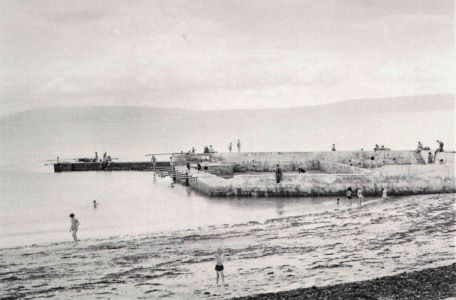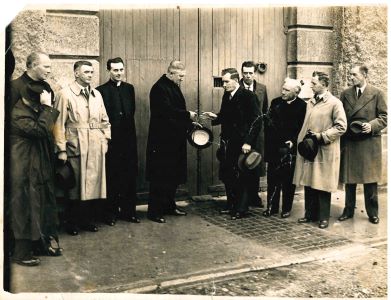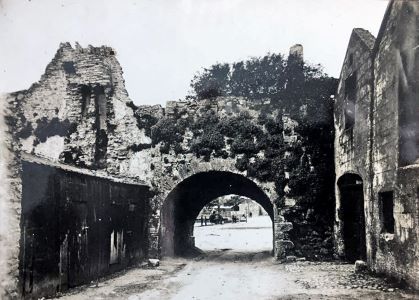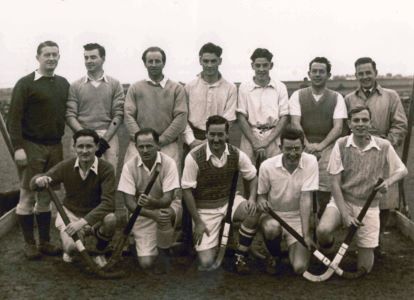Old Galway
Dancing feet in the Hangar

by Tom Kenny
Early in 1922, the urban council decided to purchase the hangar and some of the huts at Oranmore Airfield which had been used by the RAF there. The price was £400. Willie Joe Simon’s tender for their removal and re-erection of was accepted. Following the assembly of the Hangar in Salthill Park, a council meeting was held there and decided that ‘a dancing floor in timber be laid down’. They also recommended that one of the sheds purchased in Oranmore ‘be erected adjoining the Hangar to be used as a kitchen and supper room’. Three councillors, John Coogan, Mr Bailey, and Martin Cooke supported the sale, other councillors said it would become a ‘white elephant’. They were wrong.
A SUMMER TRAM ON WILLIAM STREET, 1904.

by Tom Kenny
Our photograph of William Street shows the horse-drawn open-topped summer tram heading towards the terminus on Eyre Square.
The building on the left was advertised as follows; “If you want to save money go to the great London and Newcastle Tea Shop, the best and cheapest house in town for teas, sugars, groceries and provisions. And with a present or discount to the value of sixpence given with each pound makes it the best value in the country”.
THE POOLS

by Tom Kenny
The ladies and children’s bathing pools in Salthill were blessed by Canon Davis in 1930. These were two linked tidal pools which filled up when the tide came in and emptied when the tide went out. The floors were of sand so they were a perfect playground for children even when they had dried out. Thousands of children and adults learned how to swim there with Jimmy Cranny of Galway Swimming Club and Christy Dooley of Blackrock Swimming Club teaching organised groups on alternate evenings throughout the summer.
THE HANDING OVER OF GALWAY GAOL

by Tom Kenny
Galway City and County Gaols were built at the beginning of the nineteenth century on a large site which took up most of Nun’s Island. Construction was conditional on a right of way, the road all around the walls, also being built. James Hardiman, the historian described it as follows “The Prison …. Is built in the form of a crescent …. The interior of which is divided into eight wards ….. seperated by walls which form so many radii of a circle, and, terminating in the rear of the governor’s house, bringing the whole range within many of his windows, by which means he can, at a single glance, survey the entire”.
BOWLING GREEN

by Tom Kenny
Bowling Green first appears without a name on a map in 1608. It features a little later as Bóthar Alasandair or Alexander’s lane (eventually shortened to Sander’s Lane) which in turn was named after Alexander’s Tower, a medieval tower nearby. It is difficult to know exactly when the name Bowling Green originated, but we must presume there was a bowling green in the area at some point. On an Ordnance Survey map of 1839, the part of Bowling Green we see in our photograph was known as ‘Bowling Green Lane’ while the section connecting with Lombard Street was known as ‘The Bow’. Both sections are collectively known as Bowling Green today.
A VIEW FROM THE REAR OF THE SPANISH ARCH

by Tom Kenny
The Spanish Arch was not part of the original city walls but was built in 1584 as a measure to protect the city’s quays. It was originally known as Ceann an Bhalla or The Head of the Wall, a fortification that extended from Martin’s Tower to the river. Then in the 18th century, the Eyre family built Long Walk as an extension of the quays and a breakwater to construct a mud berth. A number of arches were constructed to allow access from the town to the new quay but unfortunately, an earthquake that occurred in Lisbon in 1755 resulted in a tsunami that destroyed some of these arches. In olden times, ships would have moored here unloading their cargo of Spanish wines and foodstuffs such as olive oil, spices, tea, coffee and cocoa. Later, these ships would have been replaced by Aran fishing boats unloading and selling their wares.
DANNO, THE QUINTESSENTIAL GALWEGIAN

by Tom Kenny
He was one of those people who was known to all by just the one name, Danno, and that was not even his actual name. He was born Francis Brendan Heaslip in Knocknacarra in 1938. Because he looked very like a boxing champion of the times, Danno O’Mahoney, he was given the nickname and it stuck. He was one of six siblings born to Joe Heaslip from Cork and Maureen O’Donoghue from Tuam: Minnie, Jimmy, Michael, Danno, Helen and Phil. They lived in Lenaboy Gardens in Salthill.
GALWAY HOCKEY CLUB

by Tom Kenny
In 1951 Hastings Elliott Jephson was working in the ESB in Galway when he had the idea of setting up a hockey club in the city. He and his friend George Bevis decided to see if there was merit in this notion, so they simply went from door to door around town asking people if they would have any interest in playing the game of hockey.
.png)